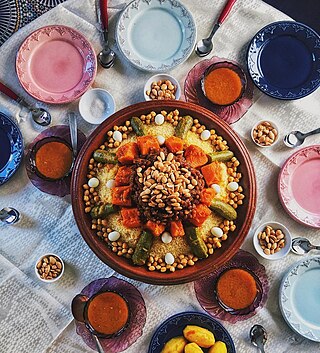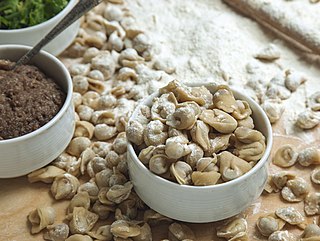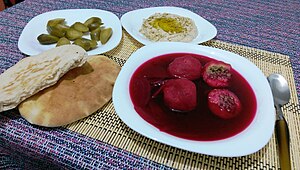
Couscous is a traditional North African dish of small steamed granules of rolled semolina that is often served with a stew spooned on top. Pearl millet, sorghum, bulgur, and other cereals are sometimes cooked in a similar way in other regions, and the resulting dishes are also sometimes called couscous.

Turkish cuisine is the cuisine of Turkey and the Turkish diaspora. Although the cuisine took its current rich form after numerous cultural interactions throughout centuries, it should not be confused with other cuisines such as Ottoman cuisine or Seljuk cuisine. Turkish cuisine with traditional Turkic elements such as yogurt, ayran, kaymak, exerts and gains influences to and from Mediterranean, Balkan, Middle Eastern, Central Asian and Eastern European cuisines.

Chicken soup is a soup made from chicken, simmered in water, usually with various other ingredients. The classic chicken soup consists of a clear chicken broth, often with pieces of chicken or vegetables; common additions are pasta, noodles, dumplings, or carrots, and grains such as rice and barley. Chicken soup is commonly considered a comfort food.
Knödel or Klöße are boiled dumplings commonly found in Central European and East European cuisine. Countries in which their variant of Knödel is popular include Austria, Bosnia, Croatia, Czechia, Germany, Hungary, Poland, Romania, Serbia, Slovakia and Slovenia. They are also found in Scandinavian, Romanian, northeastern Italian cuisine, Ukrainian, Belarusian and French (Alsatian) cuisines. Usually made from flour, bread or potatoes, they are often served as a side dish, but can also be a dessert such as plum dumplings, or even meat balls in soup. Many varieties and variations exist.

Avgolemono is a family of sauces and soups made with egg yolk and lemon juice mixed with broth, heated until they thicken.

Kibbeh is a popular dish in the Levant and middle east based on spiced lean ground meat and bulgur wheat. Kibbeh is considered to be a national dish of Lebanon and Syria.

Kofta is a family of meatball or meatloaf dishes found in Balkan, Middle Eastern, North African, South Caucasian, South Asian and Central Asian cuisines. In the simplest form, koftas consist of balls of minced meat – usually beef, chicken, pork, lamb or mutton, or a mixture – mixed with spices and sometimes other ingredients. The earliest known recipes are found in early Arab cookbooks and call for ground lamb.

Levantine cuisine is the traditional cuisine of the Levant, in the sense of the rough area of former Ottoman Syria. The cuisine has similarities with Egyptian cuisine, North African cuisine and Ottoman cuisine. It is particularly known for its meze spreads of hot and cold dishes, most notably among them ful medames, hummus, tabbouleh and baba ghanoush, accompanied by bread.

Assyrian cuisine is the cuisine of the indigenous ethnic Assyrian people, Eastern Aramaic-speaking Syriac Christians of Iraq, northeastern Syria, northwestern Iran and southeastern Turkey. Assyrian cuisine is primarily identical to Iraqi/Mesopotamian cuisine, as well as being very similar to other Middle Eastern and Caucasian cuisines, as well as Greek cuisine, Levantine cuisine, Turkish cuisine, Iranian cuisine, Palestinian cuisine, and Armenian cuisine, with most dishes being similar to the cuisines of the area in which those Assyrians live/originate from. It is rich in grains such as barley, meat, tomato, herbs, spices, cheese, and potato as well as herbs, fermented dairy products, and pickles.

Pepper Pot is a thick stew of beef tripe, vegetables, pepper and other seasonings. The soup was first made in West Africa and the Caribbean before being brought to North America through slave trade and made into a distinctively Philadelphian dish by colonial Black women during the nineteenth century.

Afghan cuisine is influenced to a certain extent by Persian, Central Asian and Indian cuisines due to Afghanistan's close proximity and cultural ties. The cuisine is halal and mainly based on mutton, beef, poultry and fish with rice and Afghan bread. Accompanying these are common vegetables and dairy products, such as milk, yogurt, and whey, and fresh and dried fruits such as apples, apricots, grapes, bananas, oranges, plums, pomegranates, sweet melons, and raisins. The diet of most Afghans revolves around rice-based dishes, while various forms of naan are consumed with most meals. Tea is generally consumed daily in large quantities, and is a major part of hospitality. The culinary specialties reflect the nation's ethnic and geographic diversity. The national dish of Afghanistan is Kabuli palaw, a rice dish cooked with raisins, carrots, nuts, and lamb or beef.

Israeli cuisine primarily comprises dishes brought from the Jewish diaspora, and has more recently been defined by the development of a notable fusion cuisine characterized by the mixing of Jewish cuisine and Arab cuisine. It also blends together the culinary traditions of the various diaspora groups, namely those of Middle Eastern Jews with roots in Southwest Asia and North Africa, Sephardi Jews from Iberia, and Ashkenazi Jews from Central and Eastern Europe.

Chicken and dumplings is a soup that consists of a chicken cooked in water, with the resulting chicken broth being used to cook the dumplings by boiling. A dumpling—in this context—is a biscuit dough, which is a mixture of flour, shortening, and liquid. The dumplings are either rolled out flat, dropped, or formed into a ball.

Tunisian cuisine, the cuisine of Tunisia, consists of the cooking traditions, ingredients, recipes and techniques developed in Tunisia since antiquity. It is mainly a blend of Mediterranean and native Punics-Berber cuisine. Historically, Tunisian cuisine witnessed influence and exchanges with many cultures and nations like Italians, Andalusians, French and Arabs.

Mizrahi Jewish cuisine is an assortment of cooking traditions that developed among the Jews of the Middle East, North Africa, Asia, and Arab countries. Mizrahi Jews have also been known as Oriental Jews.

Middle Eastern cuisine or West Asian cuisine includes a number of cuisines from the Middle East. Common ingredients include olives and olive oil, pitas, honey, sesame seeds, dates, sumac, chickpeas, mint, rice and parsley, and popular dishes include kebabs, dolmas, falafel, baklava, yogurt, doner kebab, shawarma and mulukhiyah.

Joshpara is a kind of dumpling popular in Central Asia, South Caucasus and the Middle East. They are made of unleavened wheat dough squares filled with ground meat and condiments. In observance of the Islamic dietary rules, the meat filling is usually without pork.

Ashkenazi Jewish cuisine is an assortment of cooking traditions that was developed by the Ashkenazi Jews of Central, Eastern, Northwestern and Northern Europe, and their descendants, particularly in the United States and other Western countries.

Seffa is a Maghrebi term for a dish of sweetened semolina cuscus with butter, cinnamon, and almonds. The dish may incorporate meat, and also alternatively be made with vermicelli or rice. This dish is generally consumed at the end of a meal, before dessert. It is often served at traditional marriage ceremonies and family gatherings.


















